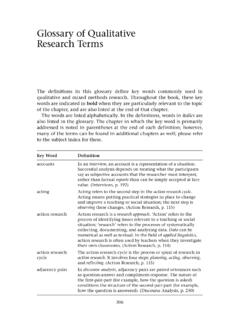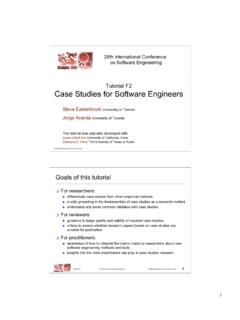Transcription of A Systems Analysis and Design Case Study for a Business ...
1 Information Systems Education Journal (ISEDJ) 13 (6) ISSN: 1545-679X November 2015 2015 EDSIG (Education Special Interest Group of the AITP) Page 77 A Systems Analysis and Design case Study for a Business Modeling Learning Experience for a Capstone CIS/IS Systems Development Class Jack Russell Barbara Russell Computer Information Systems Northwestern State University Natchitoches, LA 71497, USA Abstract The goal is to provide a robust and challenging problem statement for a capstone, advanced Systems Analysis and Design course for CIS/MIS/CS majors. In addition to the problem narrative, a representative solution for much of the Business modeling deliverables is presented using the UML paradigm.
2 A structured Analysis deliverable will be the topic of a second paper on this subject. The authors teach the Systems Analysis and Design course(s) or the Systems development course(s) at their university. The CIS senior capstone course that the primary author teaches requires that the student complete one or more Business modeling case studies. The authors have used some cases/problem statements from various Systems Analysis and Design texts; however, the authors wanted a problem statement that would challenge a Systems team at the senior undergraduate level to produce a complete static, functional and behavioral Business model that could be designed and implemented.
3 The authors believe that the narrative should include enough detail to enable the team to use either Unified Modeling Language (UML) or Structured Analysis . Keywords: static model, structural model, functional model, behavioral model, project, tasks, teams, and team members. goal of this paper is to develop a case Study ( , problem statement) and a Unified Modeling Language (UML) solution for an automated system that will 1) create and track projects, 2) assign teams to projects, 3) assign tasks to teams, 4) assign the most qualified team members to the teams, and 5) address project costing.
4 This Business system for Premier Consulting, Inc. will be titled Automated Project Management and Scheduling. The scenario of this case Study begins with the Chief Information Officer (CIO), which might be played by the instructor of the course, who approves and initiates a project and instructs the Project Director to create teams. This new case Study is destined to be used in the Advanced Systems Analysis and Development capstone class. Either a multiple team approach or single team approach will be used in developing a solution depending upon the number of student in the class.
5 Different teaming scenarios are presented in the conclusion to this paper. Information Systems Education Journal (ISEDJ) 13 (6) ISSN: 1545-679X November 2015 2015 EDSIG (Education Special Interest Group of the AITP) Page 78 Developing a collaborative learning environment is critical to the success of any IT/IS curriculum (Davis, Feinstein, Gorgone, Longenecker & Valacich, 2002). Also, an excellent Study discusses the collaborative teaming approach in detail (Ewusi_Mensah, Seal, & Abraham, 2003). Developing a quality case Study for this important capstone class drove the authors to develop the case Study that follows.
6 2. THE case Study Background The new automated system is destined to replace the current, manual, error-prone process. The automation of this activity has been welcomed by management for quite some time with the anticipation of significantly reducing the company s expenses. It is hoped that this reduction will be accomplished by 1) creating more successful teams working with greater precision, 2) completing projects on time and within budget due to a better understanding of system requirements and tasks to be completed, and 3) starting projects on time as a result of the automated project scheduling system.
7 Systems Requirements Statement The Project Director creates a project and a project profile for each project. The creation of the project profile will require the determination of project employee costs, the assignment of tasks to the project, and the assignment of a project manager. Examples of various tasks are: 1) prepare cost-benefit Analysis report , 2) produce entity relationship diagram , 3) produce class diagram , etc.). Once created, the project profile will consist of project id, project personnel cost, a list of tasks assigned, and the project manager.
8 The Project Director also creates the teams for a given project, assigns employees to the teams, and assigns a team leader. The Project Manager is responsible for assigning tasks to the various teams working on the projects(s). The Team Leader assigns tasks to the team members. For all intents and purposes, the various team leaders in the class will mimic this because they are also responsible for assigning tasks to their team members working on this case (automating these activities). Figure 1 (in the Appendix) illustrates this hierarchy.
9 Additional functionality includes: Retrieve and update information about various software projects. Retrieve and update information about various project teams. Provide information about specific team member assignments. Provide information that allows for better assignment of team members to specific teams. Provide information about the location of projects, teams assigned, and members assigned to the various teams, and what the team member skill sets are. Perform function point Analysis computations to determine the personnel cost of the project to be created. This activity would be part of the process of creating the project.
10 Provide project costing information to Accounting so that the client can be invoiced upon completion of project phases. The costing information will be determined from the function point Analysis Study alluded to above. Retrieve projects and indicate which tasks have been completed and what tasks that are currently being worked on by each project. This is expanded upon later. The Static/Structural Model Premier Consulting Incorporated is a global organization. A branch office can be either a foreign or domestic office and has a branch manager.


















